
Swainsona is a genus of about 85 species of flowering plants in the family Fabaceae, and is endemic to Australia. Plants in this genus are herbs or subshrubs with imparipinnate leaves and usually purple flowers similar to others in the family.

Swainsona galegifolia commonly known as smooth Darling pea, is a species of flowering plant in the family Fabaceae and is endemic to Australia. It is a small shrub with greyish-green leaves and flowers in white, red, pink, purple, yellow or orange.
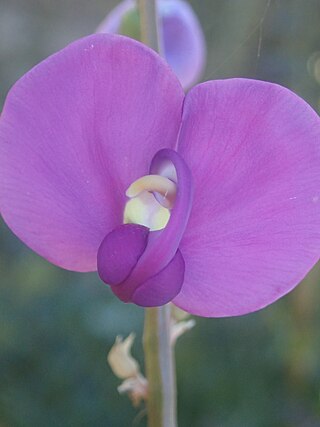
Swainsona procumbens is a plant in the pea family (Fabaceae) native to Australia and found in New South Wales, Victoria, Queensland and South Australia.
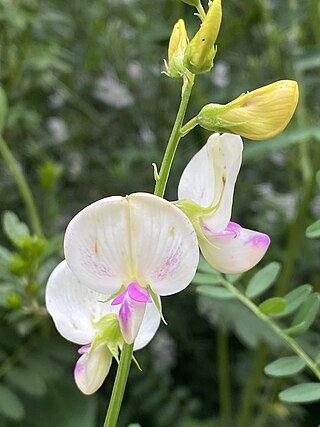
Swainsona sejuncta is a species of flowering plant in the family Fabaceae. It has pea-shaped flowers in a variety of colours, pink, cream, orange and mauve from spring to summer and is endemic to Queensland.
Goodenia cusackiana is a species of flowering plant in the family Goodeniaceae and is endemic to the north-west of Western Australia. It an erect herb, densely covered with silvery hairs and has a woody stem, narrow elliptic to lance-shaped leaves, and racemes of yellow flowers.

Goodenia eatoniana is a species of flowering plant in the family Goodeniaceae and is endemic to the extreme south-west of Western Australia. It is a perennial herb with lance-shaped leaves at the base of the plant, egg-shaped stem leaves, and racemes of blue flowers.
Goodenia macroplectra is a species of flowering plant in the family Goodeniaceae and is endemic to inland Western Australia. It an erect herb with toothed, lance-shaped leaves at the base of the plant, and racemes of dark yellow flowers with a long spur.
Goodenia micrantha is a species of flowering plant in the family Goodeniaceae and is endemic to south-western Australia. It is a prostrate to ascending herb with linear leaves at the base of the plant and racemes of small, yellowish flowers with a brownish centre.
Goodenia muelleriana is a species of flowering plant in the family Goodeniaceae and is endemic to the north-west of Western Australia. It is an ascending to erect herb with elliptic to lance-shaped leaves at the base of the plant, and racemes of yellow flowers.
Goodenia neogoodenia is a species of flowering plant in the family Goodeniaceae and is endemic to the western part of Western Australia. It is a prostrate, annual herb with round to heart-shaped or rhombic leaves and racemes or spikes of small, brownish flowers.
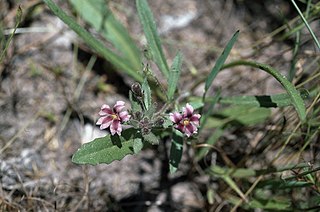
Goodenia purpurea is a species of flowering plant in the family Goodeniaceae and is endemic to the Northern Territory. It is an ascending herb with narrow oblong to lance-shaped leaves at the base of the plant, and racemes of purple flowers.

Goodenia watsonii is a species of flowering plant in the family Goodeniaceae and is endemic to the south-west of Western Australia. It is a perennial herb with egg-shaped to elliptic leaves mostly at the base of the plant, and thyrses of white, cream-coloured or bluish flowers.
Gompholobium polyzygum is a species of flowering plant in the family Fabaceae and is endemic to north-western Australia. It is an erect or prostrate shrub with pinnate leaves each with sixteen to twenty-one pairs of leaflets, and yellow-orange and greenish, pea-like flowers.

Bossiaea webbii, commonly known as water bush, is a species of flowering plant in the family Fabaceae and is endemic to the south-west of Western Australia. It is an erect, slender shrub with more or less round to kidney-shaped, minutely-toothed leaves and orange-yellow and red, pea-like flowers.

Swainsona maccullochiana, commonly known as Ashburton pea, is a species of flowering plant in the family Fabaceae. It is an upright annual with purple-reddish, pink or bluish pea-like flowers from spring to summer and is endemic to Western Australia.
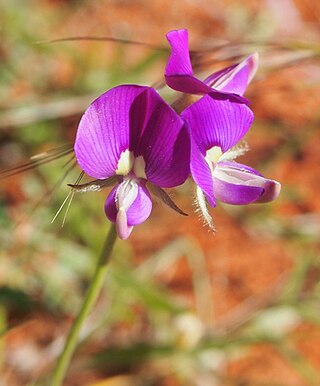
Swainsona phacoides commonly known as dwarf Swainson-pea or lilac Darling pea, is a flowering plant in the family Fabaceae. It is a small perennial herb, usually purple flowers and grows in all mainland states of Australia and the Northern Territory.
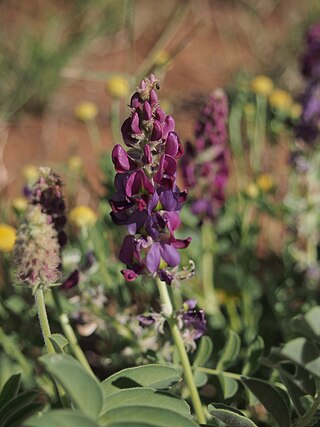
Swainsona canescens, commonly known as grey swainsona, is a flowering plant in the family Fabaceae. It is a small perennial herb with pink-purple or purple, yellow and green flowers and grows in Queensland, Western Australia and South Australia.
Swainsona acuticarinata is a species of flowering plant in the family Fabaceae and is endemic to arid areas of central Australia. It is a prostrate perennial herb with imparipinnate leaves with 5 to 11 leaflets, and racemes of purple flowers.
Swainsona adenophylla, commonly known as violet swainson-pea or violet Darling pea, is a species of flowering plant in the family Fabaceae and is endemic to arid areas of central Australia. It is a slender, erect or spreading perennial herb with imparipinnate leaves with three to nine linear to narrowly egg-shaped leaflets, and racemes of pink or purplish flowers in racemes of ten to twenty.
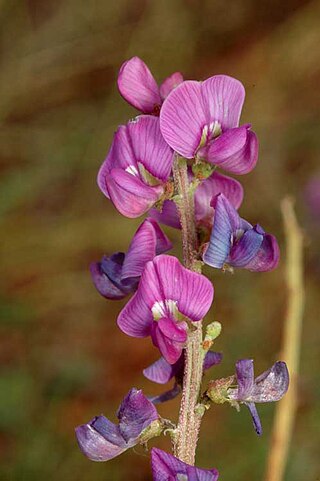
Swainsona affinis, commonly known as common poison pea, is a species of flowering plant in the family Fabaceae and is endemic to arid areas of inland Australia. It is a prostrate perennial herb with imparipinnate leaves with 7 to 25 broadly elliptic leaflets, and racemes of purple, pink, yellow or white flowers.












